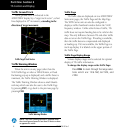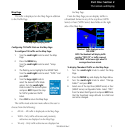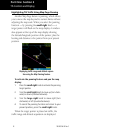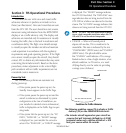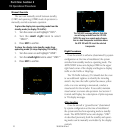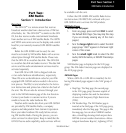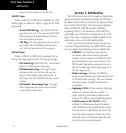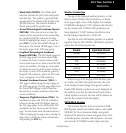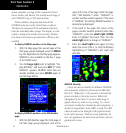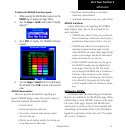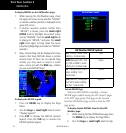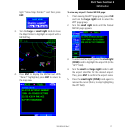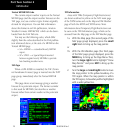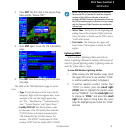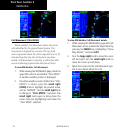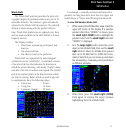
14
Part Two: Section 2
XM Weather
almostcompletecoverageofthecontinentalUnited
States,Alaska,andHawaii.Theunobstructedrangeof
eachNEXRADisupto250nauticalmiles.
When enabled, composite data from all the
NEXRADradarsitesintheUnitedStatesisshown.
Thisdataarecomposedofthemaximumreectivity
from the individual radar sweeps. The display is color-
coded to indicate the weather level severity. Informa-
tion about with sites are operational or off-line is also
available.
To display NEXRAD weather on the Map page:
1. With the Map page (the second page of the
NAV page group) displayed, press the MENU
key. The Page Menu for the Map page appears.
NEXRAD is also available on the Nav 1 page
of the 500W series.
2. Turn the large right knob to highlight “Dis-
play NEXRAD,” and then press ENT. (If “Hide
NEXRAD” appears, NEXRAD radar data are
already enabled; just press MENU again to
exit the Page Menu.)
To display NEXRAD weather on the XM Weather
page:
1. With the XM Weather page (the third page of
the NAV page group) displayed, look at the
upper left corner of the page. Under the page
title (“XM Weather”) either “NEXRAD” or
another weather product appears. If the word
is “NEXRAD,” do nothing; NEXRAD weather is
already being displayed.
2. If the word in the upper left corner of the
page is another weather product (rather than
“NEXRAD”), press the small right (CRSR)
knob to highlight that word. Then turn the
small right knob to change to “NEXRAD.”
3. Press the small right knob again to bring
down the cursor (that is, to stop the blinking
highlighting of “NEXRAD”) and retain the
selection.
NEXRAD Intensity
ColorsareusedtoidentifythedifferentNEXRAD
echo intensities (reflectivity)measuredindBZ(deci-
belsofZ).“Reectivity”istheamountoftransmitted
power returned to the radarreceiver.Reectivity
(designatedbytheletterZ)coversawiderangeof
signals(fromveryweaktoverystrong).So,amore
convenient number for calculations and comparison, a
decibel(orlogarithmic)scale(dBZ),isused.ThedBZ
values increase as the strength of the signal returned
to the radar increases. There are seven gradations for
rain,twogradationsformixedrainandsnow,andtwo
gradations for snow.
190-00356-30 Rev C



